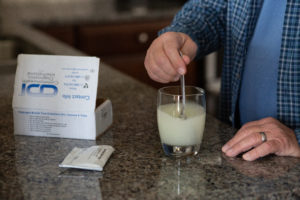As a leader in functional GI diagnostic solutions, we get asked a lot of questions from healthcare providers about breath testing. To assist in providing further education for our provider partners and your patients on your diagnostic options, here are few things to know:
What is breath testing?
Breath testing is a non-invasive, simple way to help healthcare providers diagnose common sources of digestive distress and functional GI ailments. Breath testing is based on the concept that bacteria can enter and proliferate in the small intestine and produce trace gases that are not generated by any normal function in the human body, including hydrogen and methane gases. Johns Hopkins Medicine states that “by analyzing the breath, we can measure the amount of certain gases, allowing doctors to arrive at a diagnosis quickly and accurately.”
Where are breath tests performed?
Breath tests can be performed at home, or in a medical office setting. While in-office testing was the norm prior to the COVID-19 pandemic, at-home testing has become widely popular to help limit unnecessary in-person visits. At-home breath testing meets both the Centers for Disease Control and Prevention and the American College of Gastroenterology guidelines to keep patients and healthcare staff safe.
How is a breath test performed?
Typically, patients follow a specific diet the day before administering a breath test. Patients then drink a substrate and gently exhale into a collection tube to collect a breath sample every few minutes. Breath samples are then shipped to a laboratory and analyzed by a certified laboratory technician. Certified laboratory technicians check each sample for the presence of specific gases; hydrogen and methane.
What diagnoses do breath tests determine?
Hydrogen and methane breath testing is often used if providers suspect small intestinal bacterial overgrowth (SIBO), intestinal methanogen overgrowth (IMO), Helicobacter Pylori (H. Pylori), or an intolerance to specific sugars including lactose, fructose, or sucrose. Common symptoms may include abdominal pain, abdominal bloating, distention, flatulence, and diarrhea. Many of these symptoms may overlap with irritable bowel syndrome (IBS) and inflammatory bowel disease (IBD) so it’s important to understand each medical condition and how to properly diagnose. Providers may need to utilize several breath test solutions in order to determine the cause of symptoms.
 Which breath test should I prescribe?
Which breath test should I prescribe?
If you suspect that your patient has an overgrowth of bacteria in their small intestines based on common symptoms like abdominal pain, bloating, gas, and diarrhea, then a hydrogen and methane breath test using either the lactulose or glucose substrate is the recommended diagnostic strategy from the North American Consensus on Breath Testing.
Read the 6 most common results from CDI’s Hydrogen and Methane Breath Test for SIBO & IMO.
If you suspect that your patient has an intolerance to a specific sugar, then a carbohydrate malabsorption breath test using either fructose, lactose or sucrose substrates will test for those intolerances by measuring hydrogen levels.
- Fructose Malabsorption – Test determines whether a patient has difficultly absorbing fructose, a sugar found in various fruits and wheat products.
- Lactose Malabsorption – Test determines whether a patient has difficulty absorbing lactose, as sugar found in milk and milk products.
- Sucrose Malabsorption – Test determines whether a patient has difficulty absorbing sucrose, a naturally occurring sugar found in plants and nuts.
Carbohydrate malabsorption may also be linked to high FODMAP diets.
Why choose breath testing over other diagnostic methods?
As the COVID-19 global health crisis continues, patients continue to seek easy and safe diagnostic testing options. Breath testing has become the recommended diagnosis plan for SIBO, IMO, and carbohydrate malabsorption disorders. CDI’s wide range of hydrogen and methane breath tests can be taken in the comfort of the patient’s home and are much less invasive than other diagnostic strategies including small bowel aspiration.
Download our complete breath testing primer for an in-depth overview of breath testing, including the latest trends and best practices.


